Mitigation Management
SEMA’s Mitigation Management Section works with local communities to reduce or avoid the adverse impacts that disasters have on Missourians. Hazard mitigation is any sustained action taken to reduce or eliminate long-term risk to people and property from natural hazards and their effects. This definition distinguishes actions that have a long-term impact from those that are more closely associated with immediate preparedness, response, and recovery activities.
Hazard mitigation is the only phase of emergency management specifically dedicated to breaking the cycle of damage, reconstruction, and repeated damage. Community mitigation projects range from voluntary flood buyouts to building community tornado safe rooms; replacing county- and community-owned culverts and low water crossings; stabilizing stream banks; and burying public electric utilities.
Mitigation Management administrates grants which assist local government agencies and training their employees, much of the information following is about specialized training, worksheets, and guidance documents; therefore is not aimed at the general public.
The general public will need to go through their local government to inquire regarding grants such as a buyout, tornado safe rooms, generators for critical facilities, etc. the State of Missouri does not offer any type of financial assistance, grants, or rebates for residents or businesses to purchase or construct residential safe rooms. The funding is utilized for capturing a large group of people; therefore, Missouri only administers safe rooms for Communities and School Districts.
Successful Mitigation Project Types:
Flood Buyouts
Before Mitigation


After Mitigation


Tornado Safe Rooms
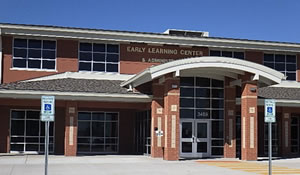
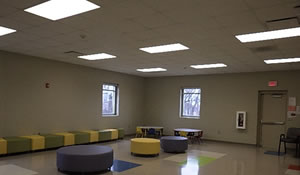
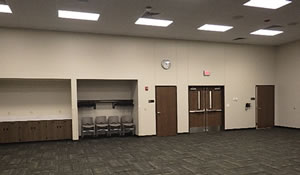
Low Water Crossing Replacement
Before Mitigation
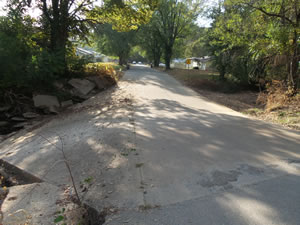
After Mitigation
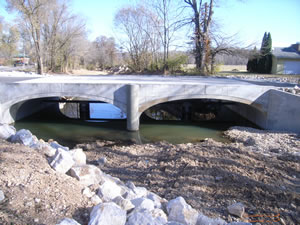
Mitigation Information for Eligible Subapplicants
Unified Hazard Mitigation Assistance (HMA) Grants
Mitigation grants (see detailed information further down the page):
- Non-disaster (annually funded) grant programs:
- Building Resilient Infrastructure & Communities (BRIC)
- Flood Mitigation Assistance (FMA)
- Post-disaster grant program:
- Hazard Mitigation Grant Program (HMGP)
Note: Please contact SEMA’s Mitigation Section to determine if funds are available under the Hazard Mitigation Grant Program or non-disaster grant programs.
HMGP Applications
HMGP Safe Room Application
- HMGP Safe Room Application
- Earthquake Assurance Template Letter
- Ops & Maintenance Plan Checklist
- Assurances - Non Construction *(Will need to download)
- Assurances - Construction *(Will need to download)
- Assurances - Lobbying *(Will need to download)
- Assurances - SF424 Form *(Will need to download)
HMGP Buyout Application
- HMGP Buyout Application
- Assurances - Non Construction *(Will need to download)
- Assurances - Construction *(Will need to download)
- Assurances - Lobbying *(Will need to download)
- Assurances - Local Match
- Assurances - Authorized Representative
- Assurances - FEMA Declaration and Release
- Assurances - Model Deed Restrictions
- Assurances - Property Site Inventory
- Assurances - SF424 Form *(Will need to download)
- Notice of Voluntary Interest Form PDF | Word
HMGP General Construction-Siren-Generator Application
- HMGP General Construction Application
- HMGP General Construction Application LWC
- Generator Worksheet Only
- Assurances - Local Match
- Assurances - Authorized Representative
- Assurances - Non Construction *(Will need to download)
- Assurances - Construction *(Will need to download)
- Assurances - Lobbying *(Will need to download)
- Assurances - SF424 Form *(Will need to download)
Other Helpful Information
- FEMA: Disaster Declarations
- Buyout (Acquisition/Demolition) Project Information
- Frequently Asked Questions Regarding a Voluntary Residential Flood Buyout Project
- Part 80 for Acquisition/Demolition – Please pay special attention to the federal requirements specified in Part 80: Property Acquisition & Relocation for Open Space of the latest edition of CFR 44.
- Buyout (Acquisition/Demolition) Documents for Local Jurisdictions
- Tornado Safe Room Guidance
- FEMA Publication 361: Design and Construction Guidance for Community Safe Room (November 2024, 5th ed.)
- FEMA Publication 320: Taking Shelter from the Storm: Building a Safe Room Inside Your House (December 2024, 6th ed.)
- FEMA Safe Room Operations and Maintenance Plan Checklist (June 2022)
- Tornado Safe Room Projects in Missouri (April 2025)
- Helpful Advertisement-RFP-RFQ Templates. Sub-applicants can utilize the Advertisement-RFP-RFQ template procuring grant writing/grant management and Architectural and/or Engineering services needed for grant writing assistance and design. These templates can be used for; Hazard Mitigation Assistance grant so it can be utilized for HMGP or FMA, should work for most if not all project types (safe room, generator, siren, electrical, etc.), Architectural and/or Engineering services allows them to revise documentation for either independently or both together.
Eligible Subapplicants
For the most part, applications must be submitted by an "eligible" city, county, special district, public school, university, or community college to be considered for funding. In some cases, counties or communities may apply for a mitigation grant on behalf of a private school, university, or two-year college. Due to various requirements, applications from individuals cannot be accepted; however, an eligible subapplicant may apply for funding to mitigate private structures in cases of flood buyouts.
All interested subapplicants must apply to the Applicant (Missouri State Emergency Management Agency). The table below identifies, in general, eligible subapplicants. For specific details regarding eligible subapplicants, refer to 44 CFR Part 206.434(a) for HMGP and 44 CFR Part 79.6(a) for FMA. See 44 CFR Part 206.2(16) for a definition of local governments.
Eligible Activities
Eligibility Planning Requirements
Two FEMA approved hazard mitigation plans (State Plan and Local Plan) are required to establish mitigation grant eligibility. Planning information is offered below.
- State Hazard Mitigation Plan (current version expires July 19, 2028)
- Local Hazard Mitigation Plans
Jurisdictions must be covered by a current Multijurisdictional Hazard Mitigation Plan to be considered an eligible applicant.
Hazard Mitigation Plans: Approved and Expiration Dates
Hazard Mitigation Plan Format Guidance (Chapters 0, 1, 2, 3, 4, 5, & other documents)
- Instructions on how to use the outline (11-05-24)
- 0 Executive Summary (07-14-24)
- 1 Introduction and Planning Process (04-22-25)
- 2 Profile and Capabilities (07-14-24)
- 3 Risk Assessment (04-22-25)
- 4 Mitigation Strategy (07-14-24)
- 5 Plan Maintenance (07-13-24)
- Data Collection Questionnaire For Local Governments
- Data Collection Questionnaire For Small Local Governments
- Data Collection Questionnaire For School Districts and Educational Institutions
- Data Collection Questionnaire For Special Districts
- Missouri Hazard Mitigation Viewer -
With the 2023 Plan Update, SEMA is pleased to provide online access to all of the risk assessment data and associated mapping for all 114 counties in the State, including the independent City of St. Louis. The Missouri Hazard Mitigation Viewer includes a Map Viewer with a legend of clearly labeled features, a north arrow, a base map that is either aerial imagery or a street map, risk assessment data symbolized the same as in the 2023 State Plan for easy reference, search and query capabilities, zoom levels to county level data and capable of downloadable PDF format maps. A Users Guide for the web-based Viewer is incorporated into the website. - Access GIS data
Click here: To subscribe to FEMA’s notification system for grant funding opportunities, including Flood Mitigation Assistance (FMA) and other programs:
(FMA ONLY) Interested jurisdictions should submit a Notice of Interest (NOI) to SEMA to be considered for the Flood Mitigation Assistance program. NOIs can be submitted at any time and are kept on file for two years. When FEMA releases the Notification of Funding Opportunity (NOFO) the NOIs are due to SEMA 30 business days after the NOFO announcement. This allows enough time for staff to conduct a thorough review, including an analysis of the cost benefit, Flood Insurance Rate Maps (FIRMs), budget, type of eligible project, and other necessary requirements. This must occur before the jurisdiction is selected for application development, which is also dependent on budget and/or declared areas. The jurisdiction will be notified if their NOI has been selected. Applications and submitted through FEMA’s grants management system (FEMA GO) before the SEMA due date provided at that time. SEMA and the jurisdiction will continue to coordinate during the application development process to submit all necessary documentation before FEMA’s final deadline. SEMA submits the applications to FEMA.
Hazard Mitigation Assistance Grant (FMA) Process:
- • FEMA releases Notification of Funding Opportunity (NOFO).
- • Jurisdiction submits Notice of Interest (NOI) to SEMA (usually 30 business days after NOFO is released).
- • SEMA provides thorough review of all applicable NOIs.
- • NOIs are selected for application development based on budget and information provided.
- • Jurisdictions of selected NOIs must submit their application using FEMA’s new grants management system (FEMA GO).
- • SEMA and jurisdiction coordinate during application development process to submit necessary documentation by FEMA’s final deadline. (SEMA’s deadline for application review is generally December 1st.).
FMA Swift Current
The requirements are similar to the FMA program. Funding is only available after a major disaster declaration following a flood-related disaster event to reduce future flood damage through the National Flood Insurance Program (NFIP). Funding is made possible through the infrastructure investment and Jobs Act (IIJA) (Bipartisan Infrastructure Law (BIL)). FEMA notifies the State if the recent declared flood disaster is qualified for FMA Swift Current. Fill out the FMA Notice of Interest (NOI) if interested in pursuing a possible project. The FMA Swift Current process is similar to the HMGP process.
Hazard Mitigation Assistance Grants (HMGP) Process:
- Presidential disaster is declared; SEMA sends out Notice of Funding Opportunity (NOI) via social media (SEMA Facebook, Twitter, SEMA website).
- Jurisdiction submits Notice of Interest (NOI) to SEMA (usually 30 business days after NOFO is released).
- SEMA provides thorough review of all applicable NOIs.
- NOIs are selected for application development based on budget and information provided.
- Selected jurisdictions will be assigned a SEMA Grants Manager to assist in submitting their application.
- SEMA and jurisdiction coordinate during application development process to submit necessary documentation by FEMA’s final deadline. This deadline can vary depending on date of disaster declaration.
Notice of Interest (NOI) Forms
Please note that an NOI form is not a project or plan application. Also note that completing an NOI does not guarantee funding. The sole purpose of the NOI is to inform SEMA Mitigation that an eligible subapplicant is interested in pursuing a mitigation project or planning grant to gage interest in specific grants that may receive funding.
- PA (Public Assistance, Section 406)
- FMA (Flood Mitigation Assistance) & Swift Current
- HMGP (Hazard Mitigation Grant Program, Section 404)
Benefit Cost Analysis (BCA) Requirements (Revised September 2020, Version 6.0)
FEMA requires that mitigation project applications be accompanied by a Benefit Cost Analysis (developed on FEMA software) that demonstrates a future savings of at least one dollar for every dollar expended on any mitigation project. A project is considered cost-effective when the BCR is 1.0 or greater.
- FEMA BCA Toolkit 6.0 Installation Instructions
- Supplement to the Benefit-Cost Analysis Reference Guide (June 2011)
Note: Use of FEMA’s Benefit Cost Analysis Revised (BCAR) software is mandatory for all non-disaster mitigation project grant applications and any HMGP projects funded from disasters declared after June 1, 2009. The software can be downloaded on FEMA's site.
FEMA GO (FEMA Grants Outcomes) Electronic Grant Application for Flood Mitigation Assistance (FMA)
FEMA’s FEMA Go is an online portal for accessing the mitigation applications used to seek funding for FMA mitigation grants. The FEMA GO applications are available at: https://go.fema.gov/login?redirect=%2F
To access this portal, the subapplicant’s CEO/Official must sign and send, by email, to SEMA a completed Authorization Matrix (see below) that identifies the staff members, by name, who will access FEMA GO on behalf of the subapplicant. The Authorization Matrix must identify the authority given to each staff member listed. The bottom of the form will be for those who will be creating the application.
The subapplicant’s staff identified to receive Sign/Submit authority on the Authorization Matrix must also have the authority to financially bind (top of form) the subapplicant’s jurisdiction to providing the required non-federal mitigation grant match and comply with all the requirements included in the grant guidance and grant agreement. Please note that SEMA recommends that sub-applicants identify at least two people to hold Sign/Submit authority in case the primary individual is not available when the application must be submitted in FEMA GO.
SEMA cannot grant Sign/Submit authority until the Authorization Matrix, with a signature is received by email. Sign/Submit authority cannot be given to contractors, grant writers, or others who do not meet the requirements included in the proceeding statements.
Each eligible staff member who needs to access FEMA GO, to work on and submit an application, must create a user profile with username and password before SEMA will have the ability to grant the authorities within FEMA GO (See Creating a FEMA GO User Profile in Missouri).
Most Recent Mitigation Grant Guidance
- NEW - 2025 Hazard Mitigation Assistance Program and Policy Guide
- Hazard Mitigation Assistance Unified Guidance 508 2-27-15: Hazard Mitigation Grant Program, Pre-Disaster Mitigation Program, and Flood Mitigation Assistance Program
- Non-disaster (annually funded) grant programs:
- Flood Mitigation Assistance (FMA)
- Cost Share Requirements:
